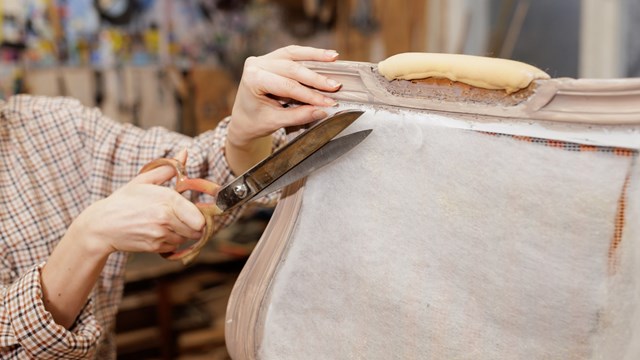
New York City has a lot going for it: it's a center for the visual and performing arts, it's a hub of international business, it's a major tourist destination - and it has some of the most fantastic architecture in the country. From Federal Style redbrick row houses in Greenwich Village to the Art Deco splendor of the Chrysler Building, New York has examples of pretty much every major building design trend of the last two centuries. The city also has some architectural features that hearken back even farther. Friezes and relief sculptures curl around pillars and doorways, complicated floral and woodland motifs grace cornices and window ledges, and alongside the ultra-modern glass-and-steel skyscrapers, winged lions, dragons, and mysterious, leafy faces - gargoyles - watch over the street below and add priceless charm to the cityscape.
In Medieval Europe - particularly France - gargoyles were more than simply decorative elements. The stone figures we're familiar with today were originally just plain, utilitarian waterspouts or dripstones affixed to the eaves of Gothic cathedrals and castles to keep rainwater from running down and pooling around foundations, thus weakening the massive structures.
Heavy ornamentation was a hallmark of Gothic architecture, so it was only a matter of time before those plain water-spigots became every bit as decorative as the buildings they served. Taking on the forms of domestic animals, people, and mythical beasts like dragons, griffins, and mischievous demons, many gargoyles incorporated the features of multiple creatures, and most had wings. The term "gargoyle" originally referred to any carved architectural figure, while figures of monsters and distorted faces were called "grotesques." Today - thanks in no small part to movies and media - any carved character, docile or demonic, is usually called a gargoyle.
Along with redirecting rain, Old World stone dragons and imps had another, less practical function; the Middle Ages in Europe was a time rife with superstition - the fall of Rome was still uncomfortably recent, the Christian Church was just beginning to hold sway over the populace, and the largely illiterate, largely impoverished masses held tight to old stories and traditions, among them stories of monsters and woodland spirits - some benevolent and some not - and the practice of hanging amulets or good-luck charms over the doors and windows of their homes.
As the influence of the Church grew across Europe, the gargoyles perched atop the town cathedral eventually came to be viewed as the monstrous protectors of the building itself and the town below. Village children (and maybe some credulous adults) believed that as they slept, the local gargoyles would patrol the town, keeping evil at bay and standing watch until the sun came up, at which point the creatures would wing back to their pedestals, and turn back into stone. Such stories may help explain why gargoyles weren't made to look cute; they were scarecrows - but built to frighten away things much nastier than birds.
Eventually, gargoyles fell out of vogue in Europe - particularly among Church administrators and dogmatic hardliners, who objected to their cost (especially considering that many gargoyles were so high up, they couldn't even be seen from the ground), and their suspiciously pagan looks. Many of the centuries-old critters were hauled off their lofty perches and destroyed, or just allowed to deteriorate until they were unrecognizable. The general populace maintained a soft spot for the ugly brutes, however, and never let the art form die out entirely.
As Europeans crossed the Atlantic and began to settle and put down roots in what was to become New York, they brought with them the architectural conventions of their countries of origin - including gargoyles and other decorative stonework. Most newcomers were more concerned with surviving and making a living than with fancying up their architecture, but by the 19th century and the dawn of the Industrial Revolution, the time - and the economic climate - was ripe for a new round of architectural exuberance.
According to Joe Chiffriller of NYC Stonecarvers - an online group devoted to the appreciation, preservation, and dissemination of all things related to the craft of stone carving in New York, "The beginnings of the stone carving trade in the States was a reflection of the Neo-Gothic movement begun in Victorian England. The fad crossed the ocean, and with it an influx of stone carvers from England, France, Germany, and Italy. Lots of work could be found here by itinerant carvers hungry for work, and they obviously left their mark on the city."
According to notes from the Brooklyn Museum's 1974 exhibit entitled New York Ornaments, gargoyles and grotesques for New York buildings were truly a native species: "Stone for carving was either quarried locally, [or] in New Jersey, or Connecticut - some of it [came from] right here in New York City, from under Washington and Pearl Streets. There were hundreds of stone yards in the New York City area - 28 in Brooklyn alone."
The 19th century encapsulated the tail end of an era of Gothic Revival - and the ready availability of materials, funding, and skilled labor gave rise to a new breed of carven creature: the American gargoyle. Buildings throughout the city - and not just churches and cathedrals - were richly ornamented, and the grotesques that perched on buildings in 19th century New York looked a lot like their European relatives, though by now, they very rarely served any purpose other than decoration. Water-drainage had come a long way by that time, and there were a number of ways to redirect rain and snowmelt.
Freed from their historic role as drain spouts and dripstones, Gothic Revival gargoyles were able to simply sit there and look good. An excellent example of Gothic Revival architecture in the city is Cass Gilbert's famous Woolworth Building, which was finished in 1913 and whose façade was composed of terra cotta panels molded into neo-Gothic ornaments, including grotesques and gargoyles.
As far as New York City is concerned, there have always been more gargoyles and decorative flourishes on residential and commercial architecture than on religious buildings - which is most likely a byproduct of the country's rather austere Puritan origins - but surprisingly little can be said about the creatures themselves, who carved them, and how they came to be chosen to sit on their respective pedestals and perches.
"There's been very little authoritative research done on American stone carving, whether in New York or elsewhere in the U.S.," says Chiffriller, "or in Canada, though it seems the large Canadian cities are rife with [gargoyles] as well."
There's even less information on the carvers themselves, who, Chiffriller says, labored "anonymously." He adds that they were "a little better paid than bricklayers, [stone carvers] weren't considered artists but artisans - paid to do a particular job for a particular construction company. Rosters of names kept by the large construction firms still exist, but nothing much is known about the craftsmen who built the more interesting facades that still exist in the city."
And those interesting façades are few and far between today where glass, steel, and poured concrete proliferate as building materials of choice, and the philosophy that "˜time is money' dictates the pace of residential and commercial construction projects. By the mid-1930s, given the high-stakes game that urban development had become in New York City, the idea of taking the time and spending the money to have someone hand-carve stone decorations for new buildings became laughable, and according to the Brooklyn Museum, "the crafts died swiftly in the 20th century - mechanization, standardized methods of workmanship, high building costs, variant wage standards, soaring insurance rates, cheap methods of production, and the increased severity of building style ended [the] era forever."
With that in mind, preservationist groups and concerned city-dwellers have worked tirelessly to document, preserve, and protect the little touches that make New York City's architecture so special - designated Historic Districts limit the scope and style of new development, and protect the valuable features that have stood the test of time - including the carvings and stonework illustrating this story.
Knowing that there are miniature monsters lurking in the urban landscape can make just walking down a residential street in the city a small adventure. Former Parks Commissioner Henry Stern is an avid fan of New York City's stony menagerie, as well as a preservationist. "There's still a great deal of architectural wildlife teeming all over the city," he says, "But demolition, the ravages of time, and - most of all - the deterioration of taste are causing the gradual extinction of these vibrant creatures."
All over the city, however, buildings large and small are still festooned with carved vines of ivy, oak leaves, human faces, animal shapes, and even the occasional winged critter, if you're lucky enough to spot one. If you'd care to launch a mini-urban safari of your own, there are a few good places to start, according to Chiffriller. "The Upper West Side is a virtual "˜gargoyle alley' that [noted author] Stephen King wrote about in his nonfiction book "Nightmares in the Sky" (Viking Penguin, 1988; and a very good read, says Chiffriller "“ed.) and the Lower East Side continues to fascinate - although not for long, as gentrification takes hold down there."
Older parts of the city yield more stony wildlife; downtown among the old buildings in the Financial District is a good place to search, as is Irving Place and along the grand stretches of Fifth and Madison Avenues. West 44th Street between Fifth and Sixth Avenues sports quite a few specimens, as do East 73rd and 74th Streets between Fifth and Park Avenues. And for those who'd rather not crane their necks around, looking for hidden beasties, there are always New York's most famous carven guardians; Patience and Fortitude, the huge stone lions crouching in front of the New York Public Library on 42nd Street and Fifth Avenue.
The pace of life in Manhattan and beyond often inures us to the interesting, even endearing characteristics of our urban surroundings, but it's well worth the two seconds it takes to look up and scan the buildings around us to see if we can't spot some of them. It's a big, crowded city, and there may be a small measure of comfort in knowing that there's a dragon or two watching over you from high above.






Leave a Comment